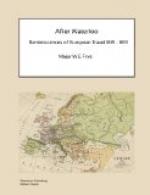We found the weather extremely hot in this valley.
Roveredo seems to be a very neat clean little city,
and the Adige flows with astonishing rapidity along
this narrow valley. The women of Roveredo have
the reputation of being very beautiful; and I recollect
having seen two Roveredo girls at Venice, who were
models of female beauty. They have a happy mixture
of German and Italian blood and manners, but Italian
is the language of the country. The second morning
of our journey we arrived and stopped to dinner at
the venerable and celebrated city of Trent. The
country we passed thro’ is much the same as
that between Verona and Roveredo, the Adige being on
our left. Trent lies also in the valley of the
Adige, shut up between the Alps. The whole valley
appears in high cultivation. The streets of Trent
are broad; the Cathedral is a remarkably fine Gothic
building. In the church of Sta Maria Maggiore
was held the famous council of Trent. There are
a great many silk mills in Trent. German as well
as Italian is spoken; indeed the two languages are
equally familiar to most of the inhabitants. In
the evening we arrived at Sabern after passing thro’
Lavis. One description will serve for these towns
and indeed for most of the towns in the Tyrol,
viz.,
that of being neat, clean and solidly built.
The inns are excellent and the inhabitants very civil.
The Adige runs close to the road and parallel to it,
nearly the whole way to Bolsano or Botzen, where Italian
ceases to be spoken and German is the national tongue.
Botzen is a large and flourishing place.
One general description will serve for the Tyrol,
regarding the towns, adjacent country, customs, inns,
inhabitants, dress and manners.
First the towns are fully as neat, clean and well
built as those in Switzerland; the country too is
very similar, tho’ not quite on so grand a scale
of sublimity; but you have fully as much variety in
mountain and valley, glacier and cascade. The
climate is exactly the same as that of Switzerland,
being very hot in the valleys in summer. The inns
are clean and good, the provisions excellent and well
cooked, the wines much better than those of Switzerland;
there is good attendance by females and all at a far
cheaper rate than in Switzerland. The Tyroleans
are much more courteous in their manners than the
Swiss; they have not that boorishness and are of more
elegant figure than their Helvetic neighbours.
The women of the Tyrol are in general remarkably beautiful,
exceedingly well shaped and of fine complexions.
In the towns the bourgeoises dress well, something
in the French style, and it is their custom to salute
travellers who pass by kissing their hands to them.
The dress of the female peasantry, however, is unpleasing
to the eye and so uncouth, that it would make the
most beautiful women appear homely. In the first
place I will speak of their head dress, of which there
are three different kinds, two of which are as bizarre




